what wheat is used to make french bread
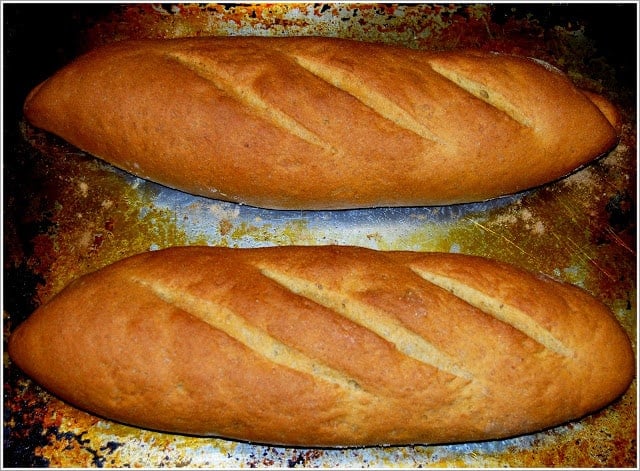
So peradventure French women don't get fatty, but I am not French and I do. Unless I sentinel what I eat.
Still, I exercise get the urge to eat some lusciously soft, heartily crusty French bread always and so ofttimes. And when I was struck by the recurring urge to bake a French bread this weekend, I decided, for a change, to make information technology healthy by incorporating as much whole wheat into the recipe equally I possibly could.
I had already posted an Like shooting fish in a barrel French Bread on this blog, and this is a healthier, whole wheat version of that recipe. It turned out astonishing, although I won't take all the credit for it-- French bread is one of the easiest breads to broil, and almost anyone tin make a pretty skillful loaf with merely a petty do.
Despite its healthy nature, this bread is also rather traditional considering it uses just flour, water and salt, as archetype French staff of life does. I did add some vital wheat gluten because I wanted the bread to be airy and light, as good French staff of life should exist.
To understand the function and importance of vital wheat gluten in wholegrain bread-making, it might aid to know the difference between whole-wheat flour, which you lot might have oft heard described as beingness depression in gluten, and refined flours similar all-purpose flour and bread flour, which take a loftier gluten content.
Refined flours are made by milling the endosperm of the wheat kernel which is a coating around the embryo of the grain and which contains a protein that, when kneaded, develops into gluten, giving bread its chewiness and structure and helping information technology to rise.
Whole-wheat flour, on the other hand, is made past milling the entire wheat kernel which includes the endosperm, the outer coating called the bran, and the embryo or the germ. Therefore, measure-for-measure, whole-wheat flour contains less endosperm than all-purpose or bread flour and therefore less of the protein that causes gluten to develop. Get it?
At the other end of the scale y'all have block flour which is refined further by stripping from it not but the bran and germ but also a expert deal of the gluten-creating poly peptide, yielding a high-starch flour that contains very little gluten. This makes information technology perfect for crumbly, tender cakes.
A quick piece of data for home cooks who tend to substitute maida, a super-refined flour that is widely used in India to make sweets and some breads, with all-purpose flour. Maida is actually much closer to cake flour than it is to all-purpose flour because of its very high starch content.
Coming to the bespeak of this postal service, when y'all make a bread with simply or mostly whole-wheat flour or other wholegrain flours like rye, you need to give the dough a poly peptide boost so it will yield a well-risen, well-structured loaf of bread instead of a heavy, dumbo loaf that you could impale someone with (hopefully not by feeding information technology to them 🙂 ). That poly peptide boost is given by adding vital wheat gluten to the recipe. If you can't find vital wheat gluten, which is sold in grocery stores like Whole Foods in pulverisation form, I'd suggest flip-flopping the ratio of whole-wheat to all-purpose flour in the recipe and leaving out the added gluten.
I used durum whole-wheat flour, the same flour I utilise to make chapatis and puris, for this bread. You can buy durum whole wheat flour in five-, 10- or 20-pound bags at Indian grocery stores and even at natural food stores like Whole Foods.
Since I've oft enough stressed in the past that bread-making is equal parts science and art, I idea it might help for yous to see pictures of most of the major steps, so I've included them here. As always, experience free to enquire if you have whatever questions.
Step-by-step Whole Wheat French bread recipe.
Mix the yeast, one cup of all-purpose flour and 1 cup of water in a big bowl. Let represent a few minutes until the mixture becomes quite bubbly, about ten-15 minutes.
At present add the vital wheat gluten, remaining flour, salt and remaining h2o. Mix to combine and then knead by hand about ten minutes or in a stand up mixer, on medium speed, near half-dozen minutes, until you accept a very smooth, rubberband and resilient dough.
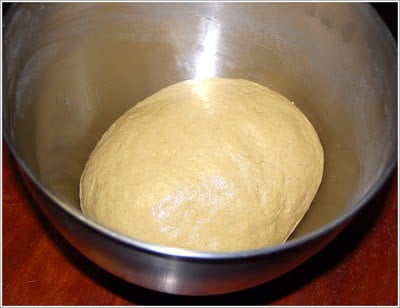
Grade the dough into a ball and place in an oiled bowl, turning over once to coat the meridian with oil. Cover loosely with a kitchen towel and gear up aside to ascension at room temperature. (In wintertime, I'd leave information technology in a cold oven with the low-cal on).

Later two hours, the dough would have more than doubled. Punch it down to remove all the gases in it, then divide it into two. Let the dough stand, covered with a kitchen towel, around 10 minutes before shaping.
Take 1 ball of dough and punch it down with your fist to release all the gases and air. You will take a six-inch round when you're done.
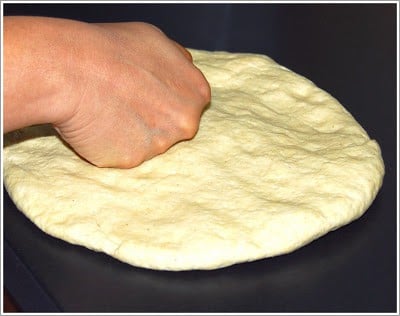
Now, coil over more than half of the dough and, using your knuckles or the heel of your hand, press information technology down into the bottom.
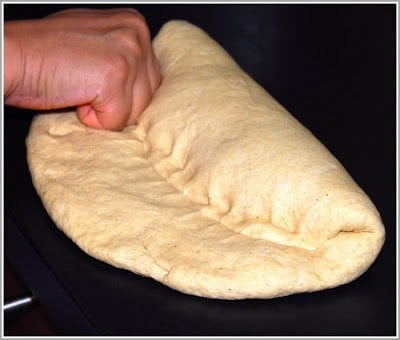
Repeat two more times, rolling the dough over each time, until you take a cylinder. Each time, press in the seams with your knuckles or the heel of your hand. If needed, at the end, pinch in the seam with your fingers to seal it. Y'all will at present take a cylinder with tapering ends, nigh six inches in length.
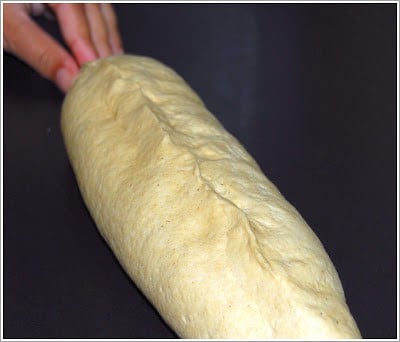
Now using the palms of your hands and fingers and without applying any pressure level, roll the dough until you take a roll about 12 inches in length. The roll should be even all over and taper off at the ends-- apply a little pressure when y'all accomplish the ends to create the tapering shape.
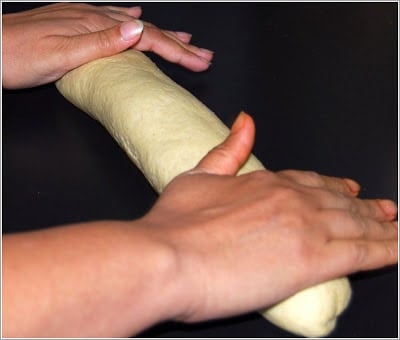
Repeat this with the other ball of dough.
Place the two loaves on a baking sail lightly greased with oil and sprinkled with cornmeal, at least 4 inches apart because they will aggrandize and rise.
Cover with a floured kitchen towel and set up aside for an hour.
With a very precipitous knife or razor, and very quickly, brand 3 long, diagonal cuts in the height of the bread. (I used a serrated steak pocketknife as you lot can come across in the motion-picture show, only if you lot're not good at this, utilize a very sharp, thin razor blade because you don't desire to deflate the dough)
Preheat the oven to 425 degrees. Five minutes before baking, spray about ½ cup water into the oven to create a steamy environment. (The water helps create a crusty loaf and also information technology creates a moist environment where the bread bakes slowly, creating more flavor).

Place the bread in the oven and close the door. Five minutes later, spray more water into the oven.

Bake about xxx minutes until the loaves are gold-brownish. Lift up the loaf to check that it separates hands from the baking canvas.
Let stand at to the lowest degree xv minutes on a rack before cut.
More vegan bread recipes
- Vegan French Bread, easy recipe
- Vegan Olive Oil Brioche
- High Poly peptide Sandwich Bread
- Vegan Cornbread
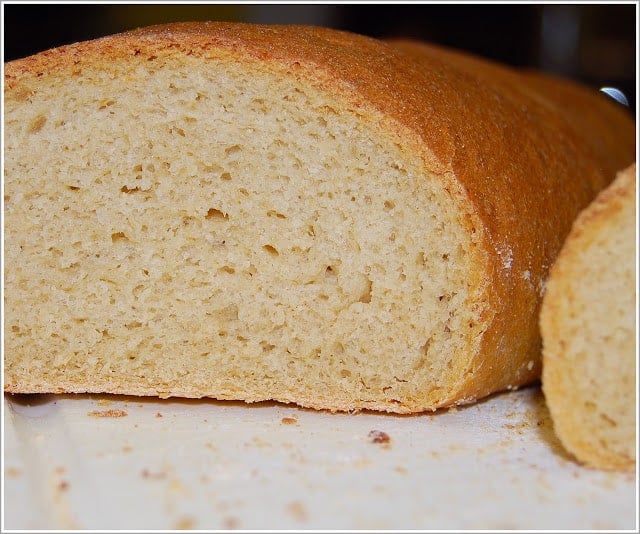
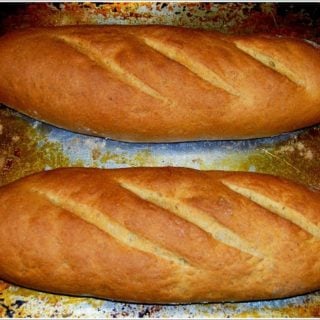
- three cups whole-wheat flour
- 2 cups unbleached all-purpose flour
- ane tablespoon vital wheat gluten
- 1 ½ teaspoon table salt
- ii cups of mildly warm water
- 2 ½ teaspoon yeast
Forbid your screen from going nighttime
-
Mix the yeast, 1 cup of all-purpose flour and ane cup of water in a large basin. Let stand for a few minutes until the mixture becomes quite bubbly, virtually ten-fifteen minutes.
-
At present add the vital wheat gluten, remaining flour, salt and remaining water. Mix to combine and and so knead past mitt nigh ten minutes or in a stand mixer, on medium speed, about six minutes, until you accept a very smooth, elastic and resilient dough.
-
Class the dough into a ball and place in an oiled bowl, turning over in one case to coat the top with oil. Cover loosely with a kitchen towel and set aside to ascension at room temperature. (In wintertime, I'd exit it in a common cold oven with the light on).
-
Afterwards 2 hours, the dough would take more than doubled. Dial it down to remove all the gases in it, and then divide it into ii. Allow the dough stand, covered with a kitchen towel, effectually x minutes before shaping.
-
Take one ball of dough and dial it down with your fist to release all the gases and air. You will accept a six-inch round when yous're done.
-
At present, curl over more than one-half of the dough and, using your knuckles or the heel of your mitt, press it downwards into the bottom.
-
Echo 2 more times, rolling the dough over each time, until you accept a cylinder. Each fourth dimension, press in the seams with your knuckles or the heel of your paw. If needed, at the finish, pinch in the seam with your fingers to seal it. You will now have a cylinder with tapering ends, about six inches in length.
-
Now using the palms of your hands and fingers and without applying whatsoever pressure, ringlet the dough until you have a roll about 12 inches in length. The roll should be fifty-fifty all over and taper off at the ends-- employ a little pressure when you lot reach the ends to create the tapering shape.
-
Echo this with the other brawl of dough.
-
Place the two loaves on a baking canvass lightly greased with oil and sprinkled with cornmeal, at to the lowest degree four inches apart because they will expand and rise.
-
Embrace with a floured kitchen towel and set aside for an hour.
-
With a very sharp knife or razor, and very quickly, make iii long, diagonal cuts in the peak of the bread. (I used a serrated steak knife equally you tin see in the picture, but if you're not practiced at this, utilise a very sharp, thin razor blade because you don't want to deflate the dough)
-
Preheat the oven to 425 degrees. Five minutes before blistering, spray about ½ cup water into the oven to create a steamy surround. (The water helps create a crusty loaf and also information technology creates a moist environment where the bread bakes slowly, creating more flavor).
-
Identify the staff of life in the oven and shut the door. Five minutes after, spray more water into the oven.
-
Broil virtually 30 minutes until the loaves are gilt-brown. Lift up the loaf to check that information technology separates easily from the blistering sail.
-
Allow stand at least 15 minutes on a rack before cutting.
Serving: 1 slice | Calories: 94 kcal | Carbohydrates: 19 chiliad | Poly peptide: four m | Fat: 1 yard | Saturated Fat: i g | Sodium: 147 mg | Potassium: 78 mg | Cobweb: 2 g | Sugar: ane g | Calcium: seven mg | Iron: i mg
Delight go out a comment and recipe rating below!
Follow Holy Cow Vegan on Instagram
Dear this vegan French bread? Check out more this collection of all the bread recipes you'll e'er need on Holy Moo-cow Vegan!
Source: https://holycowvegan.net/whole-wheat-french-bread-step-by-step/